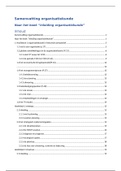Summary
Samenvatting Boek Inleiding organisatiekunde (schooljaar 2020/2021)
- Course
- Institution
- Book
Een overzichtelijk en makkelijk te lezen samenvatting van het boek Inleiding Organisatiekunde ( Ten Berge, Oteman & Kooten) uit het studiejaar 2020/2021. In de samenvatting zijn alle hoofdstukken besproken, behalve hoofdstuk 9 ( n.v.t. voor het vak Organisatiekunde)
[Show more]




